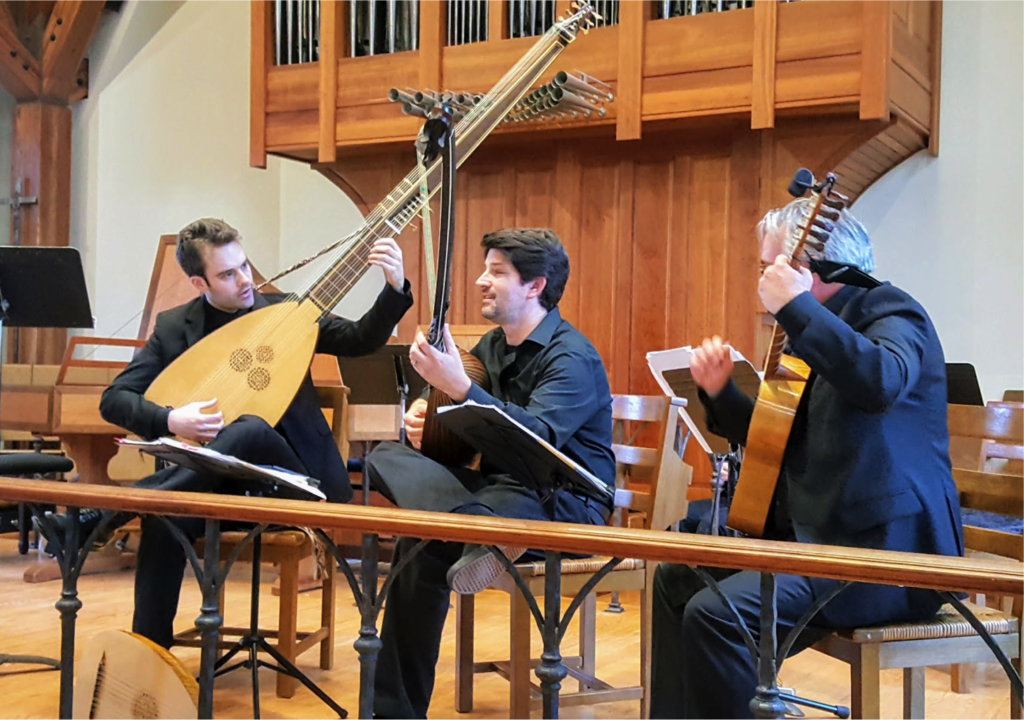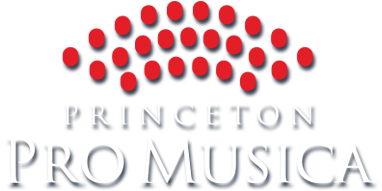An interview with Lewis R. Baratz
On March 19, Princeton Pro Musica will collaborate with the players of local Baroque ensemble La Fiocco for a performance of Bach’s St. John Passion.
For those interested in learning more about this extraordinary group of musicians, PPM marketing manager Kenny Litvack sat down with artistic director Lewis R. Baratz for a brief interview. We hope that Lewis’s insightful perspective will make you even more eager to hear our performance, and to welcome La Fiocco to the stage at Richardson Auditorium!
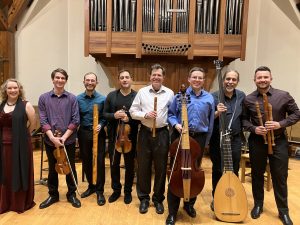
Lewis R. Baratz, fourth from the right, is the artistic director of La Fiocco
Kenny Litvack: Lewis, would you give us a brief history of La Fiocco? Did it get started because of a specific project, or was the intention always to have an ongoing Baroque ensemble?
Lewis R. Baratz: La Fiocco was founded by Lewis R. Baratz in 2009. Its original purpose was to cultivate local musicians in Bucks County who were interested in performing music of the Baroque era on period instruments. After becoming a 501(c)(3) nonprofit in 2011, the mission changed to introducing and educating people of all ages to the music of the Baroque and early Classical eras as well as the aesthetic and historical contexts of the music performed.
KL: That’s an important mission! Context is so important for Historically Informed Performance. Are the players still local to Bucks County?
LRB: La Fiocco’s initial musicians were mostly local to Bucks County and the environs. Today, most musicians come from New York and Philadelphia; others come from as far as Boston and North Carolina to perform with La Fiocco.
KL: Very impressive! I know several players for our Bach concert will be traveling from outside the area, and we’re excited to have them. What are some highlights of the ensemble’s performance history?
LRB: Some of the highlights of La Fiocco include concerts that featured the countertenor voice, with several young artists who have since gone on to perform at the Metropolitan opera and on stages throughout Europe. In 2019, we teamed with dancers Carlos Fittante and Robin Gilbert Campos in a performance of French, Italian, and Spanish Baroque dance. Also in 2019 was “Stravaganza in Eco,” where we performed polychoral music of the early 17th century with the Washington Cornett & Sackbutt Ensemble and the Bucks County Community College Madrigal Singers
KL: We keep referring to La Fiocco as a “Baroque” ensemble. For those who may not know, what sets a Baroque ensemble apart from a “modern” orchestra?
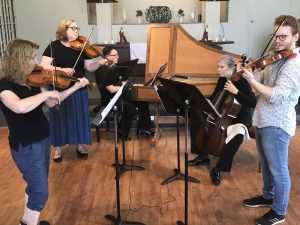
LRB: Most obviously, period ensembles perform on instruments that are either originals or copies of 17th and 18th century originals. But it goes beyond that; the players need to be experienced in historical performance techniques and completely understand what their instrument is capable of doing and how to play it expressively. For example, modern orchestras strive to achieve a uniformity of sound, with the power and expression needed to fill a large hall whereas musicians of the 17th and 18th centuries relied on a wide range of articulations to inflect meaning into their music. Modern orchestral performers are trained from an early age to be 100 percent faithful to the written score—indeed, composers of the 19th, 20th, and 21st centuries are often explicit in details concerning dynamics, phrasing, tempo, and other expressive devices. Historical performance practice, on the other hand, demands knowledge of historical context and the ability to understand the rhetorical, religious, or dance-like qualities of the music, and then the performer must have the technical ability to inflect these qualities through the use of articulation, phrasing, rhythmic alteration, and ornamentation.
KL: No wonder people specialize as early music players; it sounds like one could spend a lifetime mastering these techniques! Does La Fiocco often collaborate with other ensembles, as you’re doing with PPM?
LRB: We have had the opportunity to collaborate with La Spirita, a local viola da gamba consort; Mostly Motets, a local chamber choir that specializes in early music vocal music; the Washington Cornett & Sackbutt Ensemble; and Bucks County Community College. We’re thrilled to work with PPM now on this incredible project.
KL: I didn’t know we had a local viola da gamba consort, I’ll have to check them out! In your opinion, why is it important to continue to perform the music of the Baroque era?
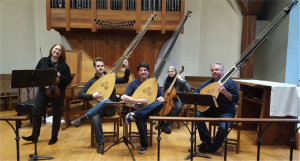 LRB: Despite Bach and Handel being on concert programs for well over a hundred years, music manuscripts and prints from the 17th and 18th centuries are still being rediscovered, transcribed, and edited all the time. There remains a wealth of little-known repertory in Western European libraries; my own research for two years in a Belgian library introduced me to more than 400 virtually unknown works by composers working in early 18th-century Brussels. After the fall of the Iron Curtain, works of both well-known and more obscure composers came to light. The amazing manuscript compiled in part by J. S. Bach of the music of Bach relatives of his father and grandfather’s generation disappeared after World War II with the Soviet Army’s return home, and it turned up in 1999 in, of all places, Kyiv, and was returned to Berlin with approximately 5000 other manuscripts.
LRB: Despite Bach and Handel being on concert programs for well over a hundred years, music manuscripts and prints from the 17th and 18th centuries are still being rediscovered, transcribed, and edited all the time. There remains a wealth of little-known repertory in Western European libraries; my own research for two years in a Belgian library introduced me to more than 400 virtually unknown works by composers working in early 18th-century Brussels. After the fall of the Iron Curtain, works of both well-known and more obscure composers came to light. The amazing manuscript compiled in part by J. S. Bach of the music of Bach relatives of his father and grandfather’s generation disappeared after World War II with the Soviet Army’s return home, and it turned up in 1999 in, of all places, Kyiv, and was returned to Berlin with approximately 5000 other manuscripts.
Today’s performers of Baroque music often bring a great deal of excitement and creativity to their work. They’re not the stuffed shirts of past days. And there are many areas we are just rediscovering, for example: Mesoamerican music, a legacy of Spanish colonialism found today in Mexico, Guatemala, El Salvador and in South America. The religious music tradition of this culture has a history mired in brutality against the indigenous peoples, something we are only beginning to understand. And even closer to home, there has been recent research into the contributions of Americans of African descent,, especially the contributions of the Hemings family, who are generally acknowledged to be the sons and grandchildren of Thomas Jefferson and Sally Hemings, and their close relatives, the Scotts, who descend from Sally Hemings’ older sister. So there is much work to do still and much to share with our audiences.
KL: Wow! Lots there to digest, thank you. For anyone coming to hear St. John Passion for the first time, what is something they can read, watch, or listen to if they want to get themselves in the right headspace for this piece
LRB: The St. John Passion is an amazing work, and a first-time listener will be fully absorbed into the exquisiteness of the music, and how Bach sets the text. First-timers might want to start with simply reading the Wikipedia article and maybe catching some excerpts on YouTube. But one must also remember that Bach was a devout Lutheran and this was simply more than a piece of music to him. It was a very deep expression of his piety, and his choice of dark keys, chromaticism, and instrumental colors, such as low members of the oboe family and the ethereal sound of violas d’amore reflect his religiosity and attempt to achieve an otherworldly quality. To this end, listeners should read a translation of the text, such as the one on the Bach Cantatas website.
KL: All very helpful suggestions, thanks! One last question– if you had to pick a favorite moment or two from the St. John, what would they be and why?
LRB: I think my favorite movements are the opening chorus, Herr unser Herrscher, which is highly emotional and sets the tone for the entire work. We know from the start, with its intense heartbeat and dissonance that something is about to happen that will change the world. The tenor aria Erwäge, wie sein blutgefärbter Rücken is also a dark movement, commenting on how the blood of Christ, after the flagellation, redeems. The unearthly sound of the two violas d’amore help create the intense dramatic effect. Then, of course, the thrilling aria Eilt, ihr angefochtnen Seele, where the bass soloist sings with a sense of urgency, telling us to hurry, to leave our dens of torment, to which the chorus chimes in, “Wohin?” (to where), and the soloist tells us: to Golgotha, to the hill of the cross, where salvation flourishes. Finally, Es ist Vollbracht another highly emotional aria, in which the alto soloist tells us the deed is accomplished; Christ has breathed his last breath on the cross. The viola da gamba solo is exquisitely elegant and sorrowful.
KL: Thank you so much, Lewis, for sharing a bit about La Fiocco and even more about the music of the Baroque era. We can’t wait to share the stage with you on March 19, and invite everyone reading to get their tickets today!
Princeton Pro Musica, along with the musicians of La Fiocco, present Bach’s St. John Passion on Sunday, March 19, 2023, at 4 p.m. in Richardson Auditorium at Princeton University. Click here for tickets.
